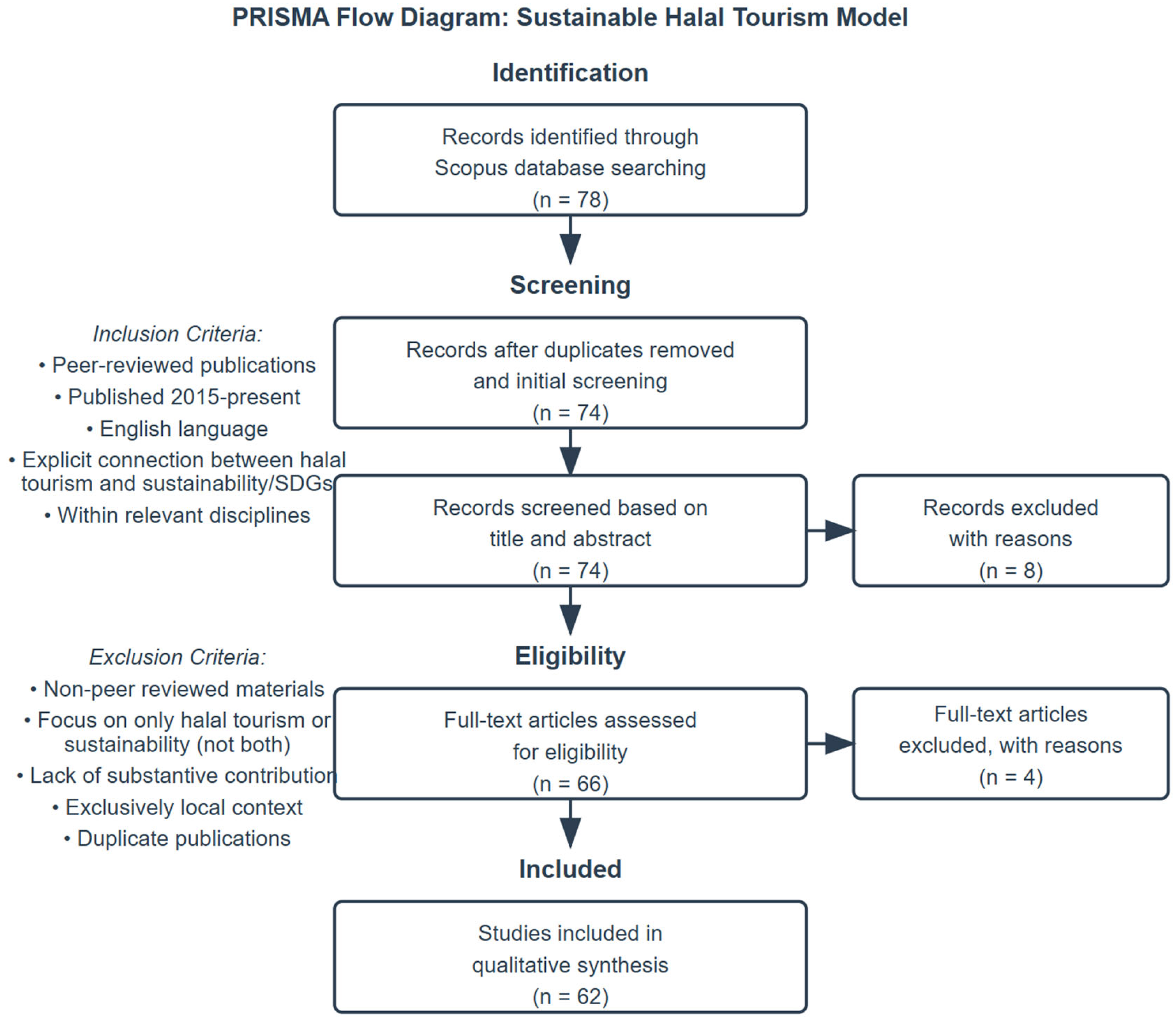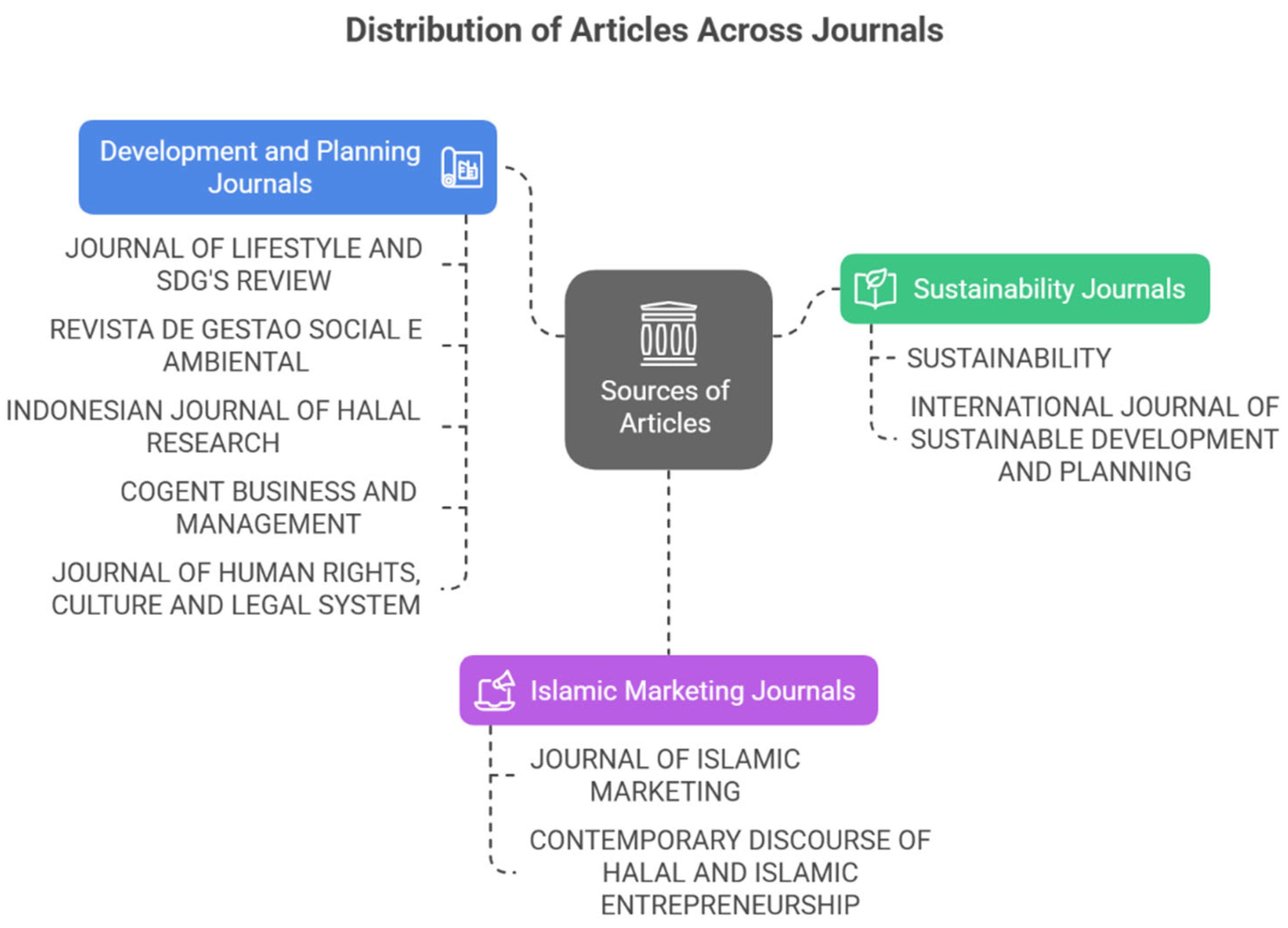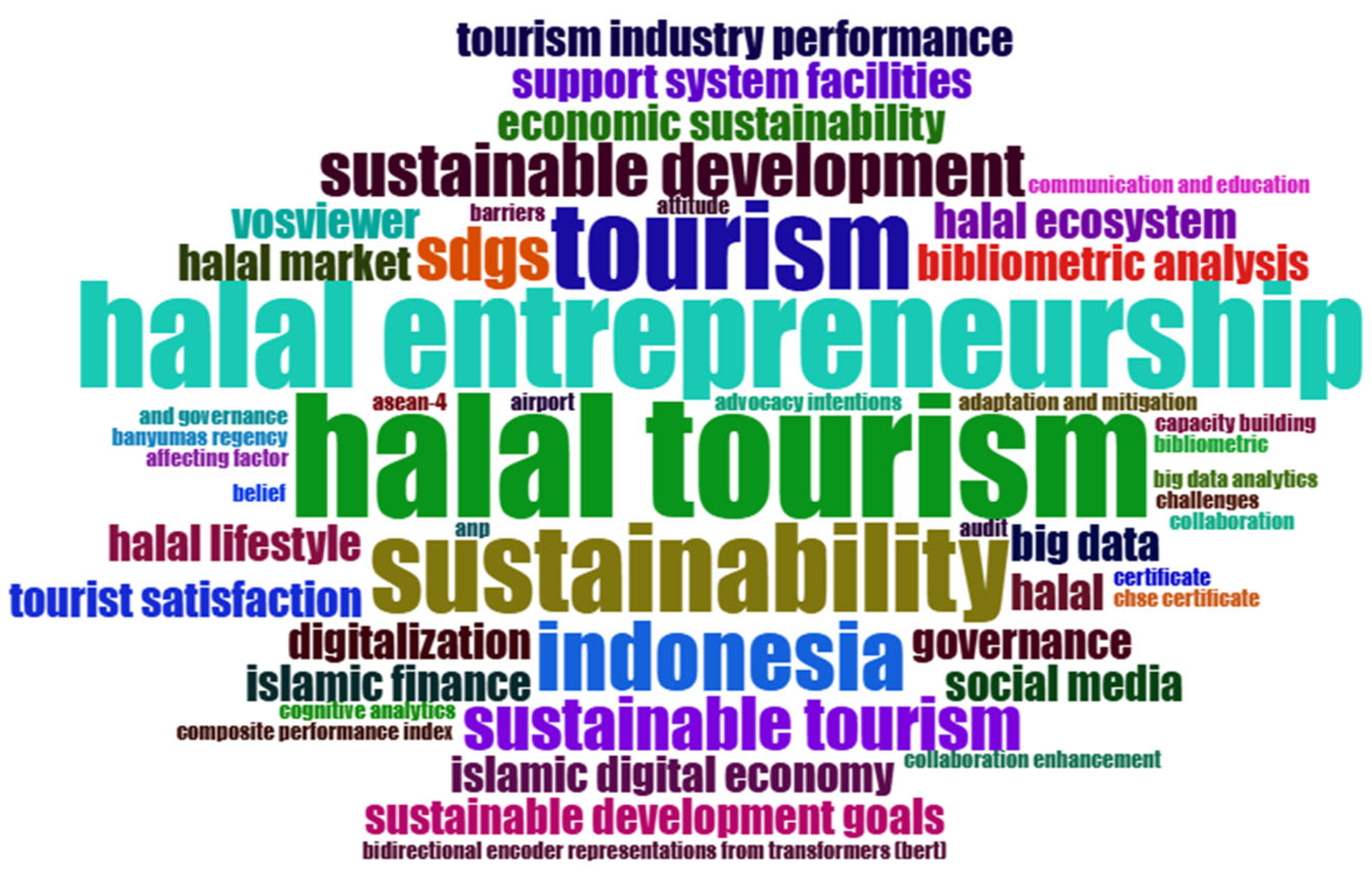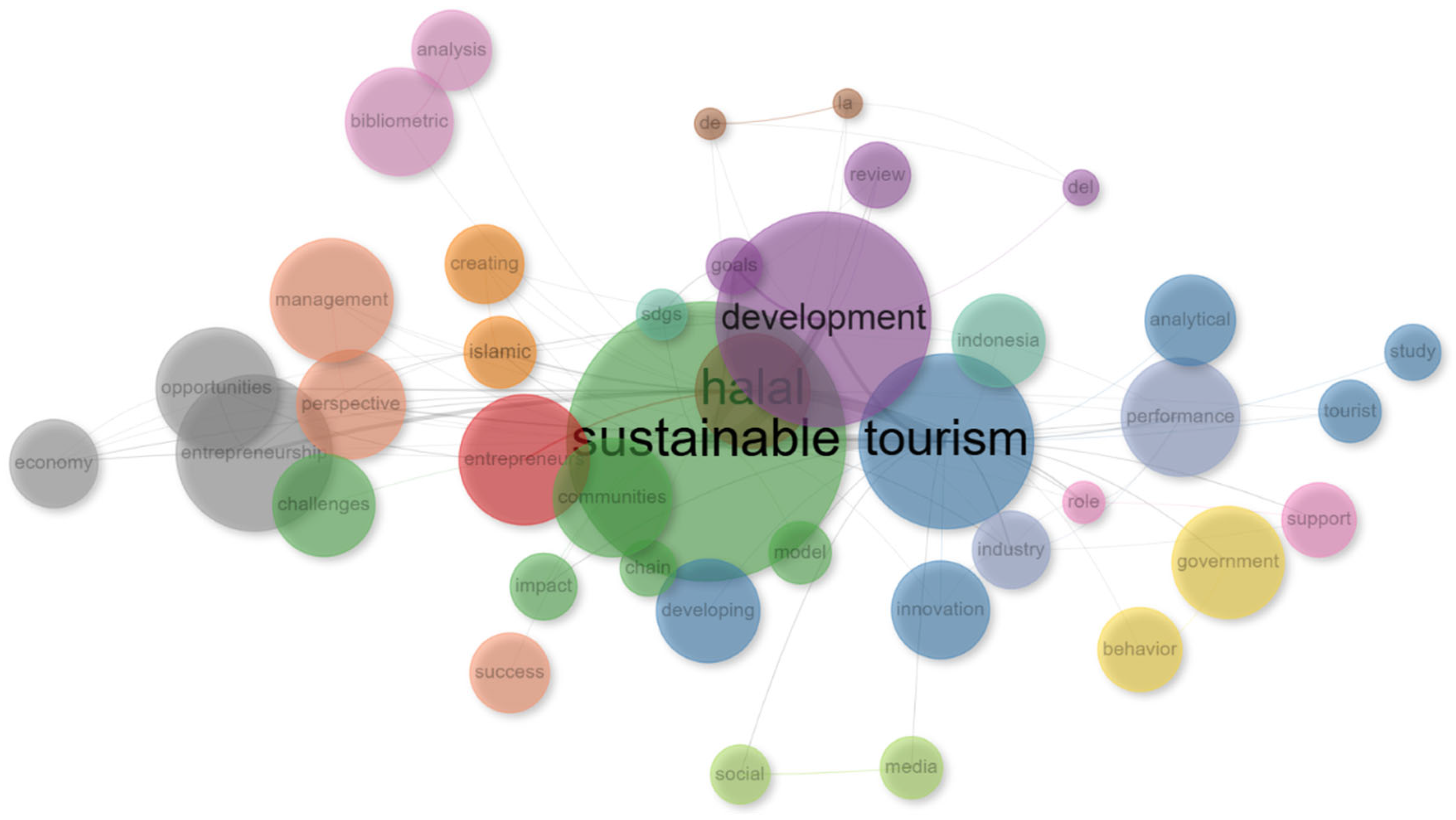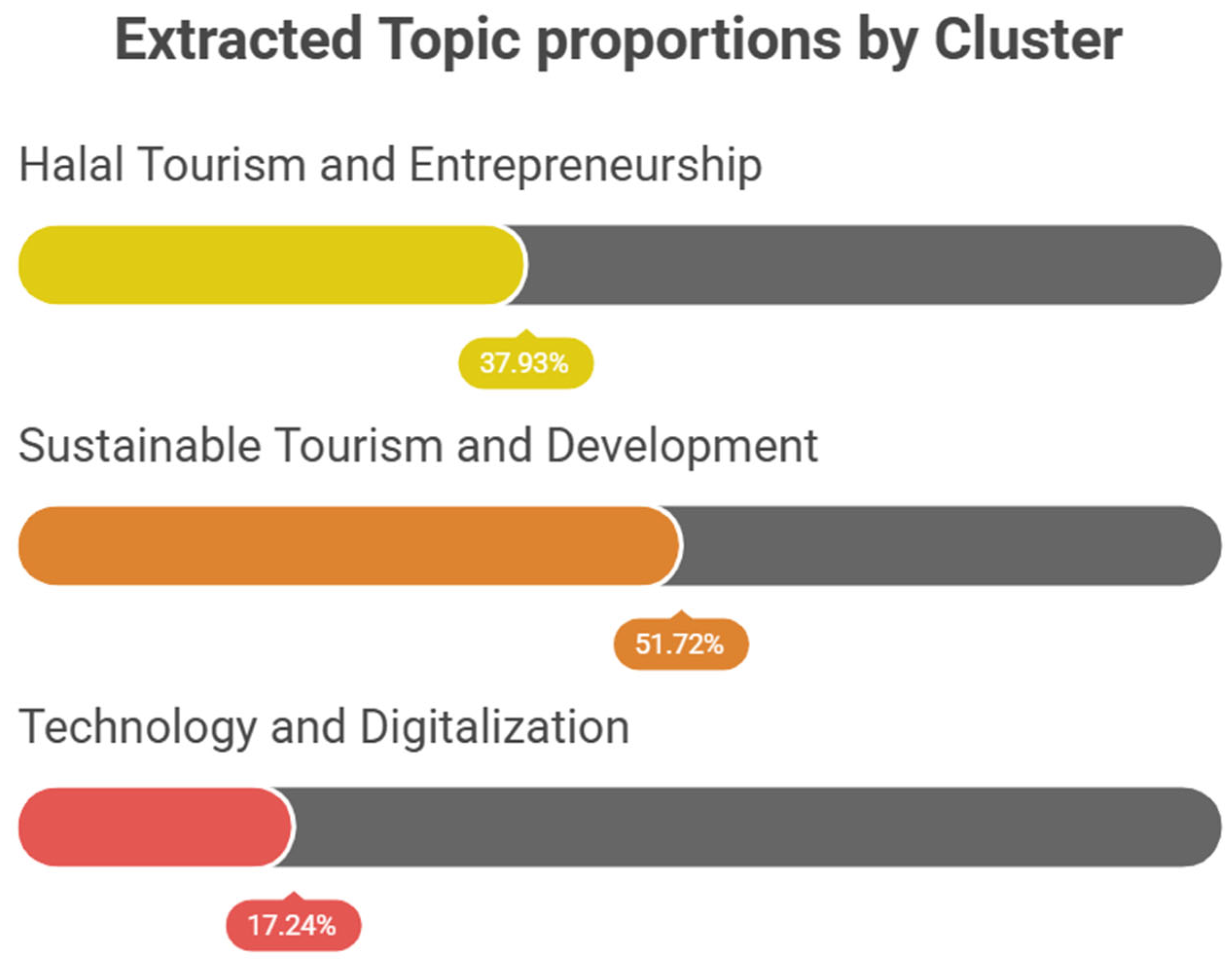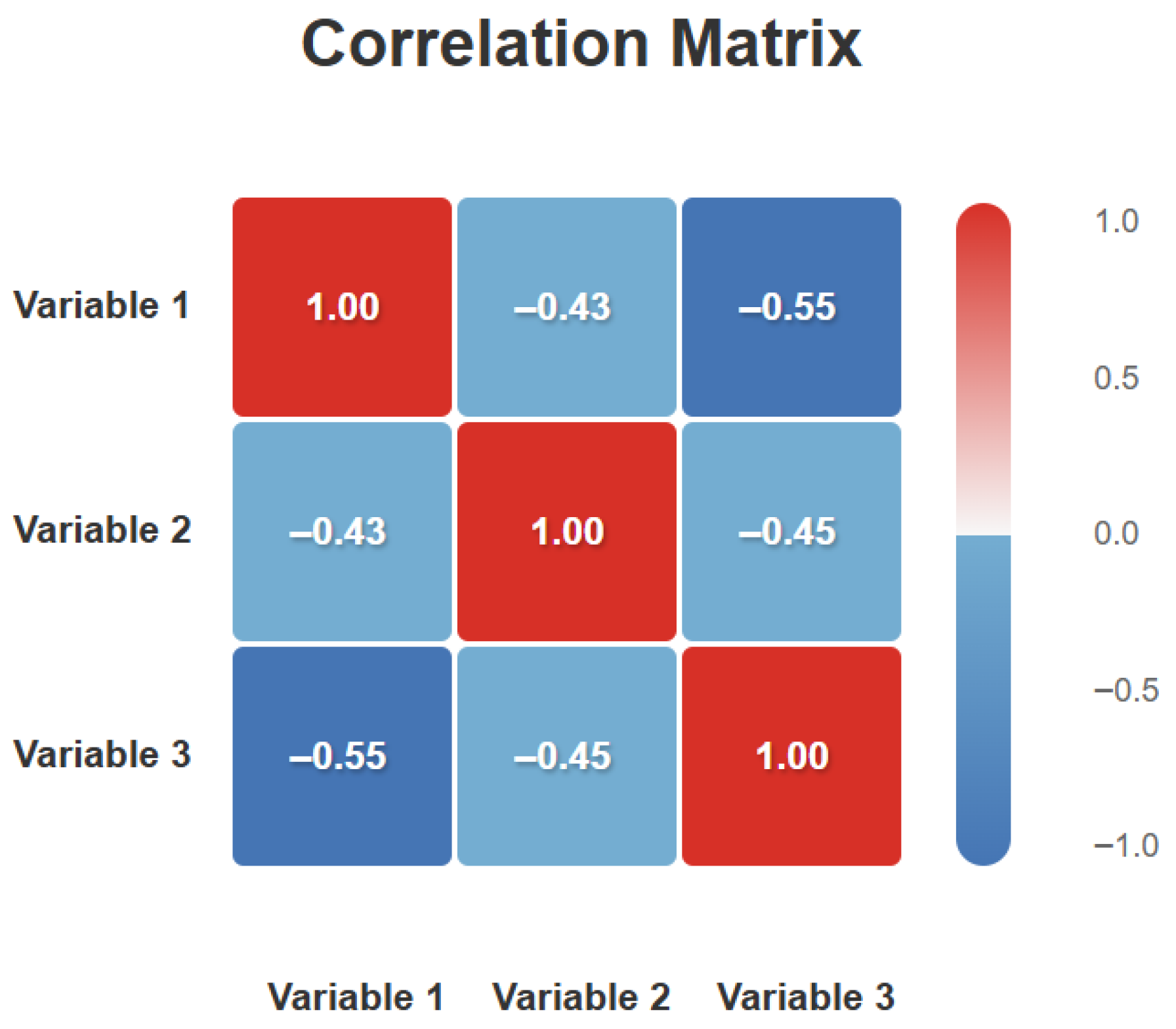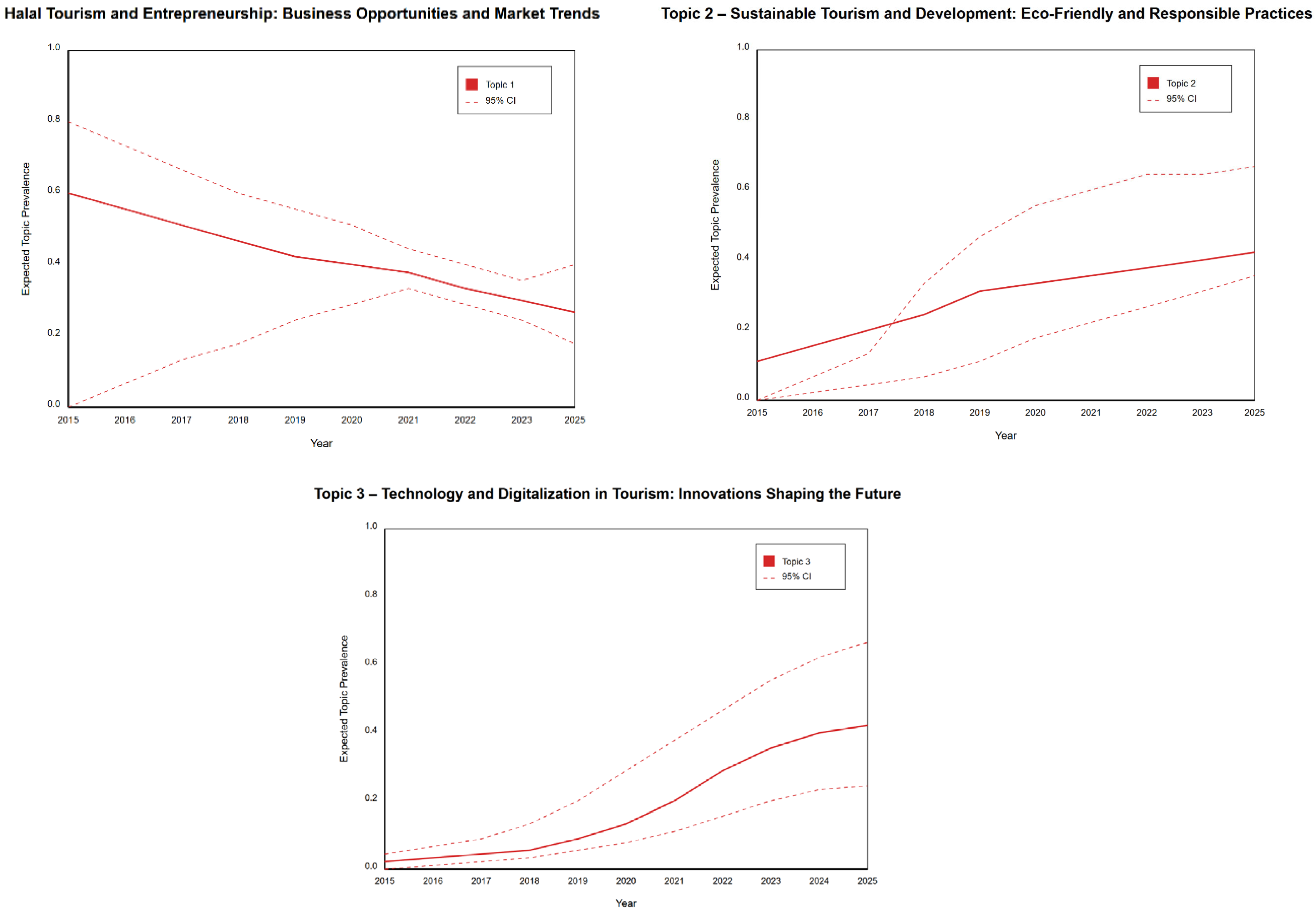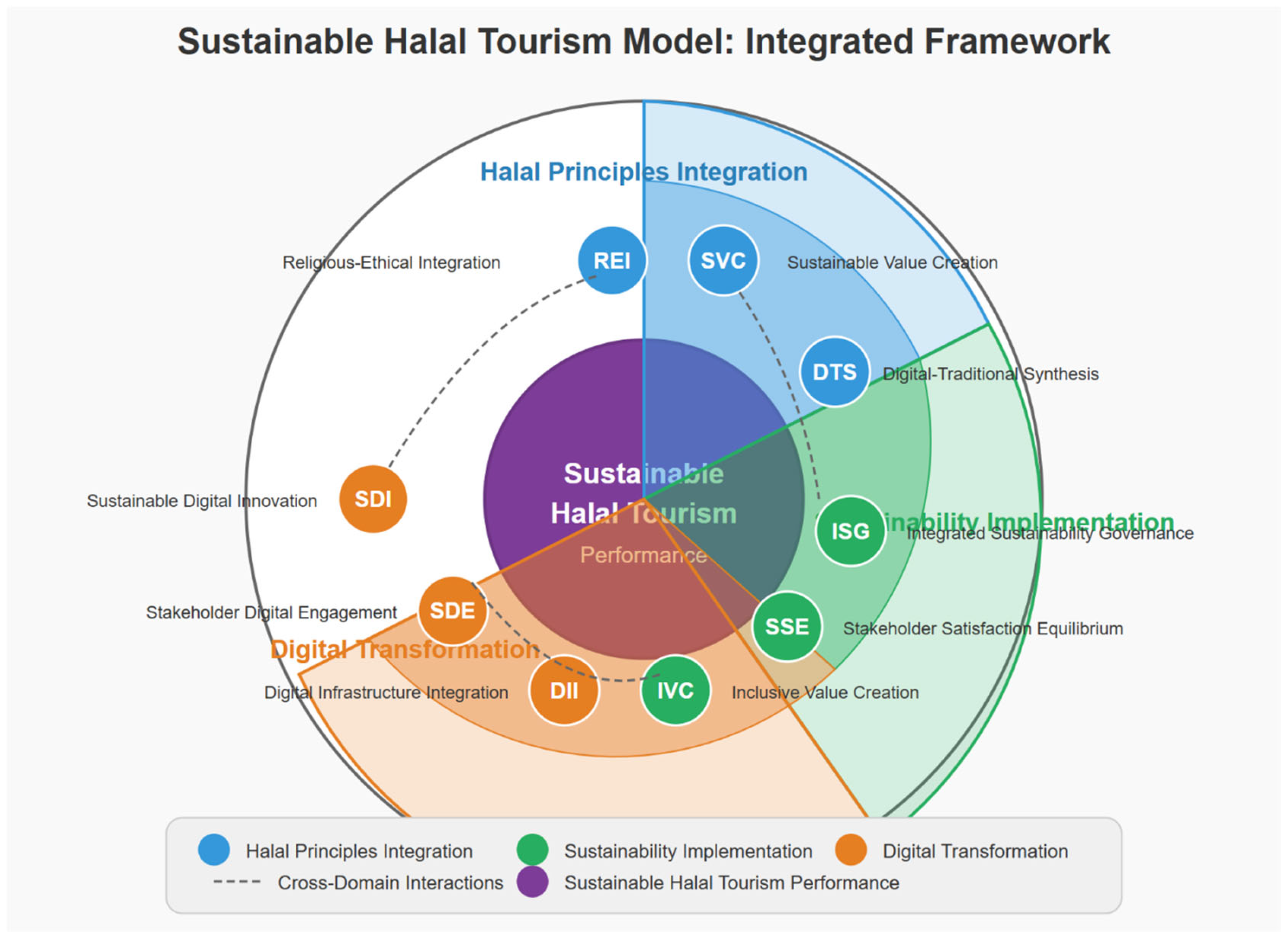The following analysis examines research trends and scholarly attention within the halal tourism literature, reflecting academic priorities and publication patterns rather than practical implementation assessments.
3.1. Descriptives
Table 1, showing the main information on halal tourism and sustainability, reveals several significant trends in this emerging research domain. The collection comprises 62 documents from 33 distinct sources, predominantly consisting of journal articles (82.3%), with smaller proportions of book chapters (12.9%) and review papers (4.8%). The notable annual growth rate of 44.22% indicates rapidly expanding scholarly interest in the integration of halal tourism with sustainability frameworks. The relatively young average document age of 1.56 years further confirms the contemporary nature of this research area, while the average citation rate of 6.581 per document demonstrates moderate scholarly impact for this developing field.
The keyword analysis identifies 253 author-supplied keywords and 130 system-generated keywords, reflecting the multidisciplinary nature of this research domain and its emphasis on both Islamic principles and environmental sustainability. The authorship analysis reveals substantial collaborative tendencies, with 216 authors contributing to the literature corpus, averaging 3.79 co-authors per document. Only 11.3% of publications have single authors, highlighting the interdisciplinary collaboration prevalent in this field. The international collaboration rate of 37.1% indicates significant cross-border research partnerships, suggesting global recognition of halal tourism’s potential contribution to sustainable development goals. This study adopts core elements of the PRISMA framework for systematic literature identification and selection while adapting the methodology to accommodate bibliometric analysis and topic modeling approaches. While we implement essential PRISMA components including structured search strategy, explicit inclusion/exclusion criteria, and transparent reporting, we acknowledge partial rather than full PRISMA 2020 compliance, particularly regarding protocol pre-registration requirements.
In addition,
Figure 2 illustrates the annual publication volume on sustainable halal tourism from 2015 to 2025, revealing a distinct pattern of growth characterized by three distinct phases. The initial period (2015–2019) demonstrates modest but consistent scholarly interest, with annual publication rates ranging from 1 to 3 articles per year, establishing the foundational literature in this emerging interdisciplinary field. This period coincides with the adoption of the UN Sustainable Development Goals in 2015, which likely stimulated initial academic interest in connecting halal tourism with broader sustainability frameworks. A notable gap appears in 2020, potentially attributable to research disruptions during the global COVID-19 pandemic, which significantly impacted tourism research priorities and data collection capabilities worldwide. The post-pandemic period (2021–2025) marks a dramatic acceleration in research output, with exponential growth beginning in 2022 (10 publications), continuing through 2023 (11 publications), and peaking in 2024 with 22 publications—representing a tenfold increase compared to the field’s early years. This surge reflects the growing recognition of halal tourism as a significant market segment requiring specialized sustainability frameworks. The partial data for 2025 (seven publications) suggests continued robust scholarly engagement, considering these figures represent only the first quarter of the year. This temporal analysis demonstrates the rapidly expanding academic interest in aligning Islamic principles with global sustainability goals in tourism contexts, coinciding with the growing economic significance of the Muslim travel market and increasing focus on sustainable development in the global tourism industry.
Furthermore,
Figure 3 depicts the distribution of publications across the primary academic sources contributing to halal tourism and sustainability research. The visualization reveals a relatively fragmented publishing landscape, with the “
Journal of Islamic Marketing” emerging as the predominant outlet, accounting for seven publications (11.3% of the corpus). This journal’s prominence highlights the strong marketing and business orientation in this research domain. Following this leader, a second tier of influential sources includes “
Tourism Management Perspectives” and “
International Journal of Tourism Research” with five publications each, and “
Journal of Sustainable Tourism” with four publications. These journals represent mainstream tourism research platforms that have recognized the significance of halal tourism’s intersection with sustainability.
The third tier comprises specialized journals such as “Current Issues in Tourism” and “International Journal of Religious Tourism and Pilgrimage” with three publications each, reflecting the multi-dimensional nature of this research area spanning both conventional tourism studies and religious tourism contexts. This distribution pattern indicates that research on halal tourism and sustainability, while gaining traction in specialized Islamic business journals, is increasingly permeating established tourism research outlets.
3.3. Bibliometric Analysis
RStudio’s Bibliophagy package was selected for bibliometric analysis due to its comprehensive visualization capabilities and robust statistical framework for analyzing scientific literature (
Tafese & Kopp, 2025). This R-based open-source tool provides significant advantages through its interactive web interface, allowing for sophisticated examination of publication patterns, collaboration networks, and thematic evolution while maintaining methodological transparency and reproducibility in the analysis of halal tourism and sustainability research.
Figure 5 presents a word cloud visualization that effectively captures the conceptual landscape of the sustainable halal tourism literature corpus. The visualization reveals that “halal tourism” and “sustainable development goals (SDGs)” emerge as the most prominent keywords (both with a frequency of 7), establishing them as the central conceptual pillars of this research domain. “Halal entrepreneurship” follows closely (frequency of 6), indicating its significance as a key operational framework through which Islamic principles are translated into business practices within the tourism sector. The terms “sustainability” and “tourism” (both with a frequency of 5) form the foundational concepts that connect religious compliance with broader industry practices. Indonesia’s notable presence (frequency of 4) signifies its position as a leading case study for halal tourism implementation within the literature. The visualization also highlights the interdisciplinary nature of this field through the presence of technology-related terms (“big data,” “digitalization,” and “social media”), financial concepts (“Islamic finance”), and analytical approaches (“bibliometric analysis”). This multidimensional keyword distribution demonstrates how sustainable halal tourism research operates at the intersection of religious principles, business innovation, technological advancement, and global sustainability initiatives, with particular emphasis on translating conceptual frameworks (SDGs) into practical implementation strategies for the rapidly evolving Muslim travel market.
In addition, the network analysis of key terms in
Table 2 below illustrates that the halal tourism and sustainable development literature corpus reveals important semantic relationships and conceptual centrality within this research domain. The metrics indicate that “research” (Betweenness: 19.872, PageRank: 0.045) and “study” (Betweenness: 17.332, PageRank: 0.044) function as the primary connective terms within the scholarly discourse, serving as bridges between multiple thematic clusters. This suggests that methodological considerations play a pivotal role in organizing knowledge within this field. Close behind these terms, “data” (Betweenness: 11.386, PageRank: 0.035), “development” (Betweenness: 9.725, PageRank: 0.035), and “sustainable” (Betweenness: 9.192, PageRank: 0.034) demonstrate high connectivity, indicating their importance in linking various research perspectives. Notably, “halal” (Betweenness: 6.811, PageRank: 0.024) shows strong but not dominant connectivity, suggesting it operates more as a contextual framework rather than the central focus of discussions. The moderate betweenness scores for terms like “tourism” (5.314), “analysis” (5.429), and “social” (4.145) further reflect the multidisciplinary nature of this research domain, bridging economic, environmental, and socio-cultural aspects. Interestingly, “SDGs” shows relatively low connectivity (Betweenness: 0.356, PageRank: 0.014), indicating that while sustainable development goals provide a conceptual foundation, they may not be explicitly centered in methodological approaches or empirical analyses. This network analysis effectively captures the complex interrelationships between Islamic principles, tourism practices, and sustainability frameworks, highlighting opportunities for more integrated conceptual frameworks in future research.
Furthermore,
Figure 6 presents a sophisticated network visualization that maps the conceptual relationships and thematic clusters within the sustainable halal tourism literature. At the center of this knowledge structure lie three dominant nodes—“sustainable,” “halal,” and “tourism”—forming the core conceptual framework around which the research domain is organized. These central terms exhibit the highest frequency of co-occurrence and serve as connective hubs linking various thematic clusters. The visualization reveals several distinct yet interconnected research communities: a development-focused cluster (purple) emphasizing “goals,” “SDGs,” and “review” approaches; an entrepreneurship ecosystem (red and orange) connecting “entrepreneurs,” “communities,” “perspective,” and “management”; a government policy dimension (yellow) linking “government,” “behavior,” and “support”; and an innovation-oriented cluster (blue) incorporating “performance,” “industry,” “innovation,” and “developing” contexts. The visualization effectively demonstrates how “Indonesia” emerges as a significant research setting, positioned at the intersection of halal frameworks and tourism applications. Methodological approaches are represented through terms like “bibliometric,” “analysis,” and “analytical,” indicating the field’s evolving research methodologies. The network structure further illustrates how concepts like “chain,” “model,” “impact,” and “challenges” serve as bridging concepts that connect different research communities, facilitating knowledge exchange across disciplinary boundaries. This visualization provides compelling evidence of sustainable halal tourism as an emerging interdisciplinary field that integrates religious principles, business innovation, policy frameworks, and sustainable development paradigms.
Clusters/Theme Identification
Table 3 presents a strategic positioning analysis of three primary research clusters within the sustainable halal tourism literature, quantified through Callon’s centrality and density metrics. The Sustainable Tourism and Development cluster demonstrates the highest strategic significance (centrality = 1.286) and well-developed internal coherence (density = 151.571), positioning it as the dominant thematic framework with substantial cross-disciplinary connections (rank 37 for centrality) and established theoretical foundations (rank 12.5 for density). With 30 publications, this cluster represents the field’s conceptual core. The Halal Entrepreneurship cluster exhibits moderate strategic positioning (centrality = 0.367) but demonstrates the strongest internal cohesion (density = 178.819), indicating a specialized, well-developed research niche with focused methodological approaches (rank 33 for centrality, rank 23 for density) represented across 22 publications. In contrast, the Technology and Digitalization cluster shows emerging strategic relevance (centrality = 0.25) with moderate internal development (density = 50), suggesting its position as an evolving research frontier that has established initial connections with other thematic areas (rank 11 for centrality) while still developing its theoretical foundations (rank 6.5 for density), currently comprising only 10 publications. This strategic positioning analysis reveals a research landscape with a well-established sustainability core, a specialized entrepreneurship domain, and an emerging technological frontier, illustrating the field’s progressive evolution from foundational sustainability frameworks toward innovative applications in entrepreneurship and digital transformation.
3.4. Topics/Themes Identified Through STM
A Structural Topic Model (STM) approach was selected for this research due to its advanced capabilities in uncovering latent thematic structures while accounting for document-level metadata, which is particularly crucial for analyzing the evolution of robotics research (
Tamakloe & Park, 2023). STM extends traditional topic modeling by incorporating document-level covariates, enabling the examination of how research themes vary across different journals and time periods (
Sharma et al., 2021).
First, the document-topic attention distribution is modeled using a logistic-normal distribution:
In Equation (1), Xd represents the vector of covariates for document d, Γ is the matrix of coefficients capturing the relationship between covariates and topic prevalence, and Σ is the covariance matrix for the topics (on the logistic scale).
Second, the topic-word distributions are formed by combining multiple components:
In Equation (2), mv represents the baseline log frequency of word v, κk,v captures the deviation specific to topic k, captures the main effect of covariate yd on the word, and captures potential interaction effects between the topic and the covariate. These log probabilities are then exponentiated and normalized (e.g., via softmax) across the vocabulary V to yield the final topic-word probability distributions, denoted . If no content covariates are used, this simplifies to βk.
Third, the topic assignment for each word follows a multinomial distribution:
Finally, the observed words are generated conditionally on their topics:
In Equation (4) β represents the collection of all topic-word distributions, and is the specific distribution for the assigned topic k = zd,n given the document’s content covariates yd.
This mathematical framework enables STM to effectively model relationships between document metadata and topical content while maintaining computational tractability through variational inference methods (
Roberts et al., 2019).
Figure 7 illustrates the proportional distribution of the three primary research clusters identified within the sustainable halal tourism literature corpus. The visualization reveals that Sustainable Tourism and Development represents the dominant research theme, accounting for 51.72% of the analyzed publications. This majority share demonstrates the field’s strong orientation toward integrating halal tourism practices with established sustainability frameworks and development goals. Halal Tourism and Entrepreneurship emerges as the second most prominent cluster with 37.93% representation, indicating substantial scholarly interest in business models, market opportunities, and operational frameworks that align Islamic principles with commercial viability in the tourism sector. Technology and Digitalization appears as an emerging research frontier with 17.24% representation, reflecting the nascent but growing attention paid to technological applications, digital marketing strategies, and innovative platforms supporting halal tourism operations. The proportional distribution across these three clusters provides valuable insights into the field’s current research priorities and evolutionary trajectory, suggesting a progressive development from foundational sustainability frameworks toward entrepreneurial applications and technological innovations.
In addition,
Figure 8 of showing the correlation matrix visualization provides critical insights into the thematic relationships among the three identified research clusters in the sustainable halal tourism literature. The diagonal elements uniformly display perfect positive correlations (1.00) as expected, representing each cluster’s internal consistency. The off-diagonal elements reveal nuanced interconnections between research domains. Notably, there exists a moderate negative correlation (−0.42) between Cluster 1 (Halal Tourism and Entrepreneurship) and Cluster 2 (Sustainable Tourism and Development), suggesting these represent somewhat divergent research approaches with limited conceptual overlap; scholars focusing on business dimensions tend to employ different methodological frameworks than those emphasizing sustainability integration. More pronounced negative correlations appear between Cluster 3 (Technology and Digitalization) and both Cluster 1 (−0.55) and Cluster 2 (−0.45), indicating that technological research in this field has developed as a relatively distinct domain with specialized methodologies and conceptual frameworks that diverge from both entrepreneurial and sustainability-oriented approaches. This correlation structure reveals a research landscape characterized by complementary rather than integrated thematic clusters, where each domain contributes unique perspectives to the collective understanding of sustainable halal tourism
The topic prevalence analysis reveals a significant transformation in sustainable halal tourism research priorities over the 2015–2025 decade. Topic 1 (Halal Tourism and Entrepreneurship) demonstrates a clear declining trajectory from its dominant position (0.59) in 2015 to a more specialized role (0.26) by 2025, reflecting the maturation of foundational business frameworks. Simultaneously, Topic 2 (Sustainable Tourism and Development) exhibits steady growth from 0.10 to 0.41, indicating increasing prioritization of sustainability principles within the field. Most remarkably, Topic 3 (Technology and Digitalization) shows exponential growth from near-absence (below 0.05) in early years to substantial representation (0.41) by 2025, accelerating notably after 2020 in alignment with pandemic-driven digital transformation. The confidence intervals across all topics demonstrate progressive methodological refinement, with initial variability giving way to more standardized approaches. By 2025, the three research clusters converge toward balanced representation, suggesting an integrated research landscape that holistically addresses business viability, environmental responsibility, and technological advancement in sustainable halal tourism.
Figure 9 below illustrates the topic prevalence indicators of each cluster from 2015 to 2025.
Table 4 presents a structured analysis of three major research clusters identified within the tourism literature, highlighting how key themes are organized and interconnected through keyword analysis. The first cluster, “Halal Tourism and Entrepreneurship,” focuses on business opportunities and market growth within the Islamic tourism sector. This research area explores how entrepreneurs can develop offerings aligned with Islamic principles while capitalizing on the growing global Muslim travel market. The general theme revolves around practical applications (“tourism, use, develop”), while specific factors emphasize the halal certification and sustainability aspects (“halal, sustain, tourism”). This cluster reflects the industry’s response to increasing demand for religiously compliant tourism services.
The second cluster, “Sustainable Tourism and Development,” examines strategies for implementing eco-friendly and responsible travel practices. This research stream addresses how tourism can contribute to environmental protection and community well-being while remaining economically viable. Like the first cluster, it shares similar keyword patterns across all three categories, indicating significant conceptual overlap between halal tourism and broader sustainability initiatives. This convergence suggests that researchers increasingly view halal tourism as inherently connected to sustainability principles. The third cluster, “Technology and Digitalization in Tourism,” investigates innovations in digital tourism and artificial intelligence applications within the hospitality sector. Despite its distinct focus on technological implementation, this cluster shares identical keyword patterns with the previous clusters. This surprising similarity indicates that technology research in tourism consistently intersects with both halal certification concerns and sustainability initiatives, rather than existing as an isolated domain. The consistent appearance of “tourism, sustain, develop” as emerging trends across all three clusters demonstrates how sustainability has become a unifying framework that connects previously distinct research areas.
